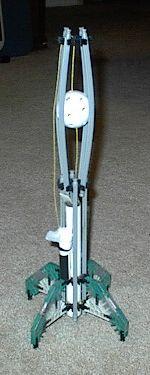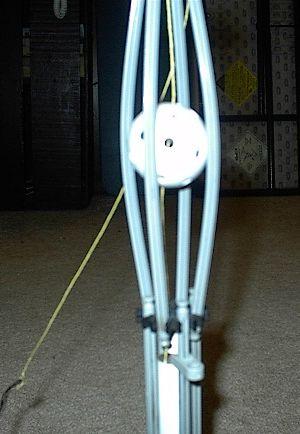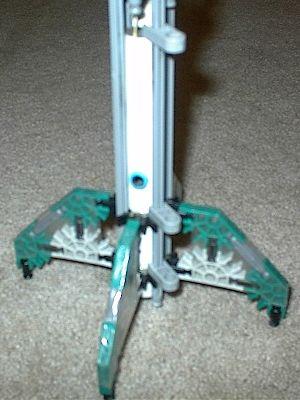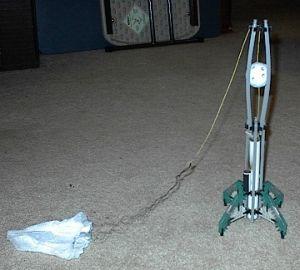Scratch K'nex Rocket Original Design / Scratch Built
Scratch - K'nex Rocket {Scratch}
Contributed by Kyle Cornelius
| Manufacturer: | Scratch |

Brief:
This is what happens when you are too bored.
Construction:
Here is the list of components that I used:
- 1 7 inch long 18mm tube (body tube)
- 1 2 inch long 13mm tube (ejection cannon)
- 1 dime (to plug the 18mm tube)
- 1 1/2" by 1" peice of cardstock (to direct the parachute away from the body tube)
- 1 2 foot peice of Kevlar®
- 1 wiffle ball
- 1 peice of 1/4 inch launch lug
- 1 motor block
- UltraKote to cover the fins for stability.
The following parts are all K'nex peices:
- 8 long gray straight peices (7 1/2 inches long)
- 4 circuler black connector peices
- 20 short black straight peices (3/4 inches long)
- 3 three gray peices that has only one place to snap
- 4 short silver strait peices (1 1/4 inches long)
- 1 light blue spacer ring
- 8 green connector peices that has four places to snap
- 4 beige connector peices that has five places to snap

One day I decided to get out my K'nex toys and see what I could make out of them. I had made a shape that looked like a fin, and I got the sudden urge to make an oddroc out of K'nex. So I snapped together some stuff till I got something that resembled a rocket. I am not going to go through all of the steps of building, because that would take forever. If you want to build one then you can basically build it from the pictures. I will highlight some of the interesting things that I did. I stuck a wiffle ball in the top part of the rocket so the strait K'nex peices curved a little bit. The Kevlar® cord actually goes through the wiffle ball's holes and through the top peice of the rocket. The Kevlar® is epoxied to a dime in the top of the 18mm body tube. The Kevlar® comes out of the top of the rocket then hangs down to the parachute which is in its own little parachute cannon. The parachute cannon is a 13mm tube that has a hole in the side of it. The 18mm tube has two holes in it: one to connect to the 13mm tube with a 1/4 inch launch lug and the other as a breather tube so the ejection gasses won't be so strong on the ejection cannon. For two of the black circuler connector peices, I had to hollow them out with a Dremel until they were very thin. I broke 2 of these before I got one right. They get extremely thin in order to fit the 18mm tube through it. For two of the launch lugs (gray peices with only one place to snap) I had to cut them off because the body tube was in the way. The third was snapped on above the body tube. For the fins, you have to add clear UltraKote and iron them on with a hobby iron. Otherwise, this will be very unstable.
 Confusing?
Yes, I know. Just look at the pictures and you'll get it.
Confusing?
Yes, I know. Just look at the pictures and you'll get it.
Finishing:
Other than the Ultrakot on the fins, there was no finishing for this bird.
Flight:
All flights have been made on Estes C6-3 motors.
Flight one through four did not have the clear UltraKote on the fins. My dad and I kept flying it anyway because it was so much fun but it was not stable. I then finally went to the hobby store and purchased some clear UltraKote and a hobby iron. This did the trick. The next four flights were perfect with a straight boost to around 200 feet (it's really heavy) and eject the parachute. Flight eight came around at Southern Thunder 2005. Not real sure what happened, but it was unstable. Of course, the time that I'm in front of people that happens. It is still a great flyer.
Recovery:
The parachute never fails to come out, except when it's unstable. Recovery has
been perfect every time and the rocket sure does get people watching.

Summary:
This is a wonderful rocket that gets people watching its slow, majestic
take-offs. If you have patience and a lot of time (and K'nex) then this is a
good project.
 |
 |